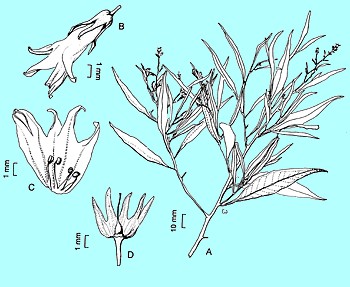
Synonymy
Duboisia arenitensis Craven, Lepschi & Haegi, J. Adelaide Bot. Gard. 16: 27 (1995).
T: NT, vicinity of Mt Gilruth, 27 March 1984, L. Craven & G. Wightman 8292; holo: CANB; iso: A, AD, DNA, E, G, K, L, MEL, MO, P, US.
Description
Shrub to 1.5 m tall, glabrous.
Leaves narrowly to very narrowly elliptic to narrowly ovate or rarely, ovate-elliptic, often falcate, sessile or with petiole to 20 mm long, 7–10 cm long, 1.5–2.5 mm wide, base attenuate, margin entire to slightly sinuate, apex long acuminate.
Inflorescence narrow, usually minutely glandular throughout; bracts linear, to 30 mm long; pedicels 1.5–3.5 mm long. Calyx 2–4.5 mm long, the lobes usually twice as long as tube. Corolla 5–8 mm long; lobes 1.5–4 mm long. Stamens 4, didynamous, 1-1.5 mm and 2-2.5 mm long. Gynoecium 2-3 mm long.
Berry not seen.
[Description modified from protologue; RMB]
Distribution and ecology
Known only from the type locality, near Mt Gilruth on the W Arnhem land plateau, NT.
Found in shrubby woodland on sandy alluvium of a seasonal creek of the sandstone plateau.
Notes
According to the authors of this species there is no one characteristic which separates it from the other three known Duboisia species. However the single collection known occurs well outside the distributional range of the rest of the species.
A table is provided in the protologue in which a number of characteristics are compared for all 4 species. Clearly D. leichhardtii should be able to be easily distinguished from the rest of the species by its longer pedicels in flower and its longer corolla lobe length, but D. arenitensis overlaps in most attributes with D. hopwoodii and D. myoporoides, and these will be more difficult to distinguish.
Selected specimens
Known only by the type collection.
Derivation of epithet
Derived from the geological name for sandstone, arenite and the Latin termination -ensis, meaning 'pertaining to sandstone', a reference to its habitat.
Images and information on web
References to the possible toxic properties of Duboisia species can be found with a search in the FDA Poisonous Plant Database
A discussion of the tropane alkaloids which occur in Duboisia and other Anthocercideae can be found in Griffith & Lin (2000).
Ref: W.J. Griffin & G.D. Lin (2000). Chemotaxonomy and geographical distribution of tropane
alkaloids. Phytochemistry 53: 627–628.